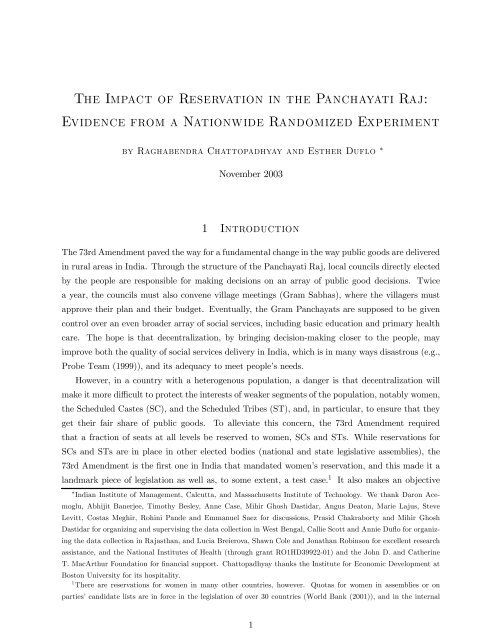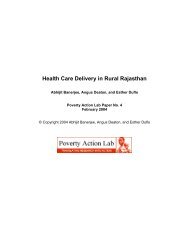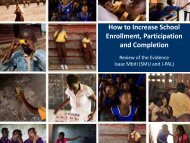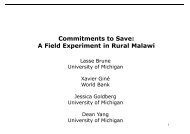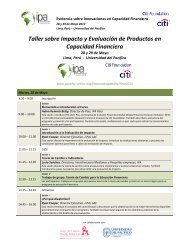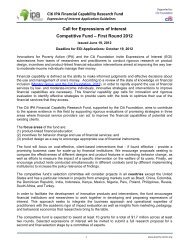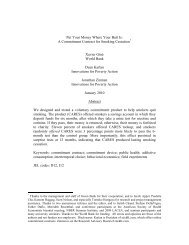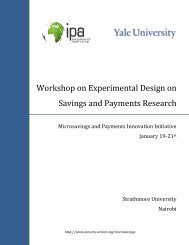The Impact of Reservation in the Panchayati Raj - Innovations for ...
The Impact of Reservation in the Panchayati Raj - Innovations for ...
The Impact of Reservation in the Panchayati Raj - Innovations for ...
You also want an ePaper? Increase the reach of your titles
YUMPU automatically turns print PDFs into web optimized ePapers that Google loves.
<strong>The</strong> <strong>Impact</strong> <strong>of</strong> <strong>Reservation</strong> <strong>in</strong> <strong>the</strong> <strong>Panchayati</strong> <strong>Raj</strong>:Evidence from a Nationwide Randomized Experimentby Raghabendra Chattopadhyay and Es<strong>the</strong>r Duflo ∗November 20031 Introduction<strong>The</strong> 73rd Amendment paved <strong>the</strong> way <strong>for</strong> a fundamental change <strong>in</strong> <strong>the</strong> way public goods are delivered<strong>in</strong> rural areas <strong>in</strong> India. Through <strong>the</strong> structure <strong>of</strong> <strong>the</strong> <strong>Panchayati</strong> <strong>Raj</strong>, local councils directly electedby <strong>the</strong> people are responsible <strong>for</strong> mak<strong>in</strong>g decisions on an array <strong>of</strong> public good decisions. Twicea year, <strong>the</strong> councils must also convene village meet<strong>in</strong>gs (Gram Sabhas), where <strong>the</strong> villagers mustapprove <strong>the</strong>ir plan and <strong>the</strong>ir budget. Eventually, <strong>the</strong> Gram Panchayats are supposed to be givencontrol over an even broader array <strong>of</strong> social services, <strong>in</strong>clud<strong>in</strong>g basic education and primary healthcare. <strong>The</strong> hope is that decentralization, by br<strong>in</strong>g<strong>in</strong>g decision-mak<strong>in</strong>g closer to <strong>the</strong> people, mayimprove both <strong>the</strong> quality <strong>of</strong> social services delivery <strong>in</strong> India, which is <strong>in</strong> many ways disastrous (e.g.,Probe Team (1999)), and its adequacy to meet people’s needs.However, <strong>in</strong> a country with a heterogenous population, a danger is that decentralization willmake it more difficult to protect <strong>the</strong> <strong>in</strong>terests <strong>of</strong> weaker segments <strong>of</strong> <strong>the</strong> population, notably women,<strong>the</strong> Scheduled Castes (SC), and <strong>the</strong> Scheduled Tribes (ST), and, <strong>in</strong> particular, to ensure that <strong>the</strong>yget <strong>the</strong>ir fair share <strong>of</strong> public goods. To alleviate this concern, <strong>the</strong> 73rd Amendment requiredthat a fraction <strong>of</strong> seats at all levels be reserved to women, SCs and STs. While reservations <strong>for</strong>SCs and STs are <strong>in</strong> place <strong>in</strong> o<strong>the</strong>r elected bodies (national and state legislative assemblies), <strong>the</strong>73rd Amendment is <strong>the</strong> first one <strong>in</strong> India that mandated women’s reservation, and this made it alandmark piece <strong>of</strong> legislation as well as, to some extent, a test case. 1 It also makes an objective∗ Indian Institute <strong>of</strong> Management, Calcutta, and Massachusetts Institute <strong>of</strong> Technology. We thank Daron Acemoglu,Abhijit Banerjee, Timothy Besley, Anne Case, Mihir Ghosh Dastidar, Angus Deaton, Marie Lajus, SteveLevitt, Costas Meghir, Roh<strong>in</strong>i Pande and Emmanuel Saez <strong>for</strong> discussions, Prasid Chakraborty and Mihir GhoshDastidar <strong>for</strong> organiz<strong>in</strong>g and supervis<strong>in</strong>g <strong>the</strong> data collection <strong>in</strong> West Bengal, Callie Scott and Annie Duflo <strong>for</strong> organiz<strong>in</strong>g<strong>the</strong> data collection <strong>in</strong> <strong>Raj</strong>asthan, and Lucia Breierova, Shawn Cole and Jonathan Rob<strong>in</strong>son <strong>for</strong> excellent researchassistance, and <strong>the</strong> National Institutes <strong>of</strong> Health (through grant RO1HD39922-01) and <strong>the</strong> John D. and Ca<strong>the</strong>r<strong>in</strong>eT. MacArthur Foundation <strong>for</strong> f<strong>in</strong>ancial support. Chattopadhyay thanks <strong>the</strong> Institute <strong>for</strong> Economic Development atBoston University <strong>for</strong> its hospitality.1 <strong>The</strong>re are reservations <strong>for</strong> women <strong>in</strong> many o<strong>the</strong>r countries, however. Quotas <strong>for</strong> women <strong>in</strong> assemblies or onparties’ candidate lists are <strong>in</strong> <strong>for</strong>ce <strong>in</strong> <strong>the</strong> legislation <strong>of</strong> over 30 countries (World Bank (2001)), and <strong>in</strong> <strong>the</strong> <strong>in</strong>ternal1
and rigorous analysis <strong>of</strong> its effects particularly important.A necessary condition <strong>for</strong> <strong>the</strong> efficacy <strong>of</strong> <strong>the</strong> reservation policy is that <strong>the</strong> elected representativeshave <strong>in</strong>dependent power and autonomy, over and above not only <strong>the</strong> direct control <strong>of</strong> <strong>the</strong> villagers(exerted through vot<strong>in</strong>g or through <strong>the</strong> Gram Sabhas), but also above <strong>the</strong> control <strong>of</strong> <strong>the</strong> bureaucracy,<strong>the</strong> parties’ hierarchies, and <strong>the</strong> local elites. Thus, by ask<strong>in</strong>g whe<strong>the</strong>r or not reservations make adifference <strong>for</strong> political outcomes we can start answer<strong>in</strong>g two important questions on <strong>the</strong> <strong>Panchayati</strong><strong>Raj</strong>. First, do <strong>the</strong> Panchayat leaders matter at all? Second, do <strong>the</strong>y make decisions that betterreflect <strong>the</strong> needs <strong>of</strong> <strong>the</strong>ir own groups?This paper summarizes some <strong>of</strong> <strong>the</strong> f<strong>in</strong>d<strong>in</strong>gs from our research project on local decentralization(Chattopadhyay and Duflo (2003a), Chattopadhyay and Duflo (2003b)). 2 We answer <strong>the</strong>se questionsus<strong>in</strong>g two data sets we collected <strong>in</strong> two districts, Birbhum, <strong>in</strong> West Bengal, and Udaipur, <strong>in</strong><strong>Raj</strong>asthan. In both places, we conducted detailed village surveys, from which we learned both <strong>the</strong>types and <strong>the</strong> locations <strong>of</strong> <strong>the</strong> public goods provided on <strong>the</strong> ground s<strong>in</strong>ce <strong>the</strong> last election. We alsocollected data on Gram Sabhas and compla<strong>in</strong>ts to <strong>the</strong> GP (by men and women), and we <strong>the</strong>re<strong>for</strong>eknow, <strong>in</strong> each place, what women and men seem to care most about.A key feature <strong>of</strong> <strong>the</strong> reservation policy is that <strong>the</strong> seats to be reserved were randomly allocated,which ensures that <strong>the</strong> only difference between reserved and unreserved villages is that some <strong>of</strong><strong>the</strong>m were picked to be reserved, while some were not. With a large enough sample, this meansthat if we f<strong>in</strong>d any difference between <strong>the</strong> types <strong>of</strong> goods that are provided <strong>in</strong> GPs that are reserved<strong>for</strong> women Pradhans and <strong>in</strong> those that are not, this must reflect <strong>the</strong> impact <strong>of</strong> <strong>the</strong> policy. We firstshow that women <strong>in</strong>vest more <strong>in</strong> goods that are relevant to <strong>the</strong> needs <strong>of</strong> local women: water androads <strong>in</strong> West Bengal; water <strong>in</strong> <strong>Raj</strong>asthan. <strong>The</strong>y <strong>in</strong>vest less <strong>in</strong> goods that are less relevant to <strong>the</strong>needs <strong>of</strong> women: non-<strong>for</strong>mal education centers <strong>in</strong> West Bengal; roads <strong>in</strong> <strong>Raj</strong>asthan. In Birbhum,where we have data on <strong>in</strong>vestments <strong>in</strong> hamlets populated by SCs, STs and <strong>the</strong> general populationwith<strong>in</strong> each village, we also show that SC Pradhans <strong>in</strong>vest a larger share <strong>of</strong> public goods <strong>in</strong> SChamlets than do non-SC Pradhans.This research thus shows that some <strong>of</strong> <strong>the</strong> fears expressed regard<strong>in</strong>g decentralization are notfounded: Local leaders seem to have some effective control over decisions, even when <strong>the</strong>y arewomen or SCs. Moreover, it <strong>in</strong>dicates that <strong>the</strong> <strong>of</strong>t-heard anecdotal evidence regard<strong>in</strong>g womenbe<strong>in</strong>g entirely controlled by <strong>the</strong>ir husbands when <strong>in</strong> <strong>of</strong>fice should not be given too much weight.Correct<strong>in</strong>g <strong>the</strong> imbalances <strong>in</strong> political agency leads to a correction <strong>of</strong> imbalance <strong>in</strong> o<strong>the</strong>r spheresas well (Sen (1999)). <strong>Reservation</strong>s <strong>of</strong> electoral seats may <strong>the</strong>re<strong>for</strong>e be an effective tool to safeguard<strong>the</strong> <strong>in</strong>terest <strong>of</strong> <strong>the</strong> weaker groups.rules <strong>of</strong> at least one party <strong>in</strong> 12 countries <strong>of</strong> <strong>the</strong> European Union (Norris (2001)).2 More details can be found <strong>in</strong> <strong>the</strong>se papers.2
2 Institutions2.1 <strong>The</strong> Panchayat System<strong>The</strong> Panchayat is a system <strong>of</strong> village-level (Gram Panchayat), block-level (Panchayat Samiti),and district-level (Zilla Parishad) councils, members <strong>of</strong> which are elected by <strong>the</strong> people, and areresponsible <strong>for</strong> <strong>the</strong> adm<strong>in</strong>istration <strong>of</strong> local public goods. Each Gram Panchayat (GP) encompasses10,000 people <strong>in</strong> several villages (between 5 and 15). <strong>The</strong> GPs do not have jurisdiction over urbanareas, which are adm<strong>in</strong>istered by separate municipalities. Voters elect a council, which <strong>the</strong>n electsamong its members a Pradhan (chief) and an Upa-Pradhan (vice-chief). 3 Candidates are generallynom<strong>in</strong>ated by political parties, but have to be residents <strong>of</strong> <strong>the</strong> villages <strong>the</strong>y represent. <strong>The</strong> councilmakes decisions by majority vot<strong>in</strong>g (<strong>the</strong> Pradhan does not have veto power). <strong>The</strong> Pradhan, however,is <strong>the</strong> only member <strong>of</strong> <strong>the</strong> council with a full-time appo<strong>in</strong>tment.<strong>The</strong> Panchayat system has existed <strong>for</strong>mally <strong>in</strong> most <strong>of</strong> <strong>the</strong> major states <strong>of</strong> India s<strong>in</strong>ce <strong>the</strong> early1950s. However, <strong>in</strong> most states, <strong>the</strong> system was not an effective body <strong>of</strong> governance until <strong>the</strong>early 1990s. Elections were not held, and <strong>the</strong> Panchayats did not assume any active role (Ghatakand Ghatak (1999)). In 1992, <strong>the</strong> 73rd Amendment to <strong>the</strong> Constitution <strong>of</strong> India established <strong>the</strong>framework <strong>of</strong> a three-tiered Panchayat system with regular elections throughout India. It gave <strong>the</strong>GP primary responsibility <strong>for</strong> implement<strong>in</strong>g development programs, as well as <strong>in</strong> identify<strong>in</strong>g <strong>the</strong>needs <strong>of</strong> <strong>the</strong> villages under its jurisdiction. Between 1993 and 2003, all major States but two (Biharand Punjab) had at least two elections. <strong>The</strong> major responsibilities <strong>of</strong> <strong>the</strong> GP are to adm<strong>in</strong>isterlocal <strong>in</strong>frastructure (public build<strong>in</strong>gs, water, roads) and identify targeted welfare recipients. <strong>The</strong>ma<strong>in</strong> source <strong>of</strong> f<strong>in</strong>anc<strong>in</strong>g is still <strong>the</strong> state, but most <strong>of</strong> <strong>the</strong> money that was previously earmarked<strong>for</strong> specific uses is now allocated through four broad schemes: <strong>The</strong> Jawhar Rozgar Yojana (JRY)<strong>for</strong> <strong>in</strong>frastructure (irrigation, dr<strong>in</strong>k<strong>in</strong>g water, roads, repairs <strong>of</strong> community build<strong>in</strong>gs, etc.); a smalladditional dr<strong>in</strong>k<strong>in</strong>g water scheme; funds <strong>for</strong> welfare programs (widow’s, old age, and maternitypensions, etc.); and a grant <strong>for</strong> GP function<strong>in</strong>g. 4 <strong>The</strong> GP has, <strong>in</strong> pr<strong>in</strong>ciple, complete flexibility<strong>in</strong> allocat<strong>in</strong>g <strong>the</strong>se funds. At this po<strong>in</strong>t, <strong>the</strong> GP has no direct control over <strong>the</strong> appo<strong>in</strong>tments <strong>of</strong>government-paid teachers or health workers, but <strong>in</strong> some states (Tamil Nadu and West Bengal, <strong>for</strong>example) <strong>the</strong>re are Panchayat-run <strong>in</strong><strong>for</strong>mal schools.<strong>The</strong> Panchayat is required to organize two meet<strong>in</strong>gs per year, called “Gram Samsad”. <strong>The</strong>seare meet<strong>in</strong>gs <strong>of</strong> villagers and village heads <strong>in</strong> which all voters may participate. <strong>The</strong> GP councilsubmits <strong>the</strong> proposed budget to <strong>the</strong> Gram Samsad and reports on <strong>the</strong>ir activities <strong>in</strong> <strong>the</strong> previous sixmonths. <strong>The</strong> GP leader also must set up regular <strong>of</strong>fice hours where villagers can lodge compla<strong>in</strong>tsor requests.In West Bengal, <strong>the</strong> Left Front (communist) government ga<strong>in</strong>ed power <strong>in</strong> 1977 on a plat<strong>for</strong>m <strong>of</strong>3 In <strong>Raj</strong>asthan, <strong>the</strong> chief is called a Sarpanch. In this paper, we will use <strong>the</strong> term<strong>in</strong>ology Pradhan <strong>for</strong> both states.4 Accord<strong>in</strong>g to <strong>the</strong> balance sheets we could collect <strong>in</strong> 40 GPs <strong>in</strong> West Bengal, <strong>the</strong> JRY accounts <strong>for</strong> 30% <strong>of</strong> totalGP <strong>in</strong>come, <strong>the</strong> dr<strong>in</strong>k<strong>in</strong>g water scheme, 5%, <strong>the</strong> welfare programs, 15%, <strong>the</strong> grant <strong>for</strong> GP function<strong>in</strong>g, 33%, and <strong>the</strong>GP’s own revenue <strong>for</strong> 8%. GPs can also apply <strong>for</strong> some special schemes—a hous<strong>in</strong>g scheme <strong>for</strong> SC/STs, <strong>for</strong> example.3
agrarian and political re<strong>for</strong>m. <strong>The</strong> major political re<strong>for</strong>m was to give life to a three-tiered Panchayatelectoral system. <strong>The</strong> first election took place <strong>in</strong> 1978 and elections have taken place at five-year<strong>in</strong>tervals ever s<strong>in</strong>ce. Thus, <strong>the</strong> system put <strong>in</strong>to place by <strong>the</strong> 73rd Amendment all over India wasalready well established <strong>in</strong> West Bengal. Follow<strong>in</strong>g <strong>the</strong> Amendment, <strong>the</strong> GP was given additionalresponsibilities <strong>in</strong> West Bengal. In particular, <strong>the</strong>y were entrusted to establish and adm<strong>in</strong>ister<strong>in</strong><strong>for</strong>mal education centers (called SSK), an alternative <strong>for</strong>m <strong>of</strong> education <strong>for</strong> children who do notattend school (a <strong>in</strong>structor who is not required to have any <strong>for</strong>mal qualification teaches childrenthree hours a day <strong>in</strong> a temporary build<strong>in</strong>g or outdoors).In <strong>Raj</strong>asthan, unlike West Bengal, <strong>the</strong>re was no regularly elected Panchayat system <strong>in</strong> charge<strong>of</strong> distribution <strong>of</strong> state funds until 1995. <strong>The</strong> first election was held <strong>in</strong> 1995, followed by a secondelection <strong>in</strong> 2000. S<strong>in</strong>ce 1995, elections and Gram Samsads have been held regularly, and are wellattended. <strong>The</strong> sett<strong>in</strong>g is thus very different, with a much shorter history <strong>of</strong> democratic government.As <strong>in</strong> West Bengal, <strong>the</strong> Panchayat can spend money on local <strong>in</strong>frastructure, but unlike <strong>in</strong> WestBengal, <strong>the</strong>y are not allowed to run <strong>the</strong>ir own schools.2.2 <strong>Reservation</strong> <strong>for</strong> Women, Scheduled Castes and Scheduled TribesIn 1992, <strong>the</strong> 73rd Amendment provided that one-third <strong>of</strong> <strong>the</strong> seats <strong>in</strong> all Panchayat councils, as wellas one third <strong>of</strong> <strong>the</strong> Pradhan positions, must be reserved <strong>for</strong> women. Seats and Pradhan positionswere also reserved <strong>for</strong> <strong>the</strong> two disadvantaged m<strong>in</strong>orities <strong>in</strong> India, Scheduled Castes and ScheduledTribes, <strong>in</strong> <strong>the</strong> <strong>for</strong>m <strong>of</strong> mandated representation proportional to each m<strong>in</strong>ority’s population share<strong>in</strong> each district. <strong>Reservation</strong>s <strong>for</strong> women have been implemented <strong>in</strong> all major states except Biharand Uttar Pradesh (which has only reserved 25% <strong>of</strong> <strong>the</strong> seats to women).In West Bengal, <strong>the</strong> Panchayat Constitution Rule was modified <strong>in</strong> 1993 so as to reserve onethird<strong>of</strong> <strong>the</strong> councilor positions <strong>in</strong> each GP to women, and a share equal to <strong>the</strong>ir population <strong>for</strong> SCsandSTs;<strong>in</strong>athird<strong>of</strong><strong>the</strong>villages<strong>in</strong>eachGP,onlywomencouldbecandidates<strong>for</strong><strong>the</strong>position<strong>of</strong>councilor <strong>for</strong> <strong>the</strong> area. <strong>The</strong> proportion <strong>of</strong> women elected to Panchayat councils <strong>in</strong>creased to 36%after <strong>the</strong> 1993 election. <strong>The</strong> experience was considered a disappo<strong>in</strong>tment, however, because veryfew women (only 196 out <strong>of</strong> 3,324 GPs) advanced to <strong>the</strong> position <strong>of</strong> Pradhan, which is <strong>the</strong> only onethat yields effective power (Kanango (1998)). To con<strong>for</strong>m to <strong>the</strong> 73rd Amendment, <strong>the</strong> PanchayatConstitution Rule <strong>of</strong> West Bengal was aga<strong>in</strong> modified <strong>in</strong> April <strong>of</strong> 1998 (Government <strong>of</strong> West Bengal(1998)) to <strong>in</strong>troduce reservation <strong>of</strong> Pradhan positions <strong>for</strong> women and SC/STs. In <strong>Raj</strong>asthan, <strong>the</strong>random rotation system was implemented <strong>in</strong> 1995 and <strong>in</strong> 2000 at both levels (council members andPradhans).In both states, a specific set <strong>of</strong> rules ensures <strong>the</strong> random selection <strong>of</strong> GPs where <strong>the</strong> <strong>of</strong>fice <strong>of</strong>Pradhan was to be reserved. All GPs <strong>in</strong> a district are ranked <strong>in</strong> consecutive order accord<strong>in</strong>g to<strong>the</strong>ir serial legislative number (an adm<strong>in</strong>istrative number pre-dat<strong>in</strong>g this re<strong>for</strong>m). GPs that haveless than 5% SCs (or STs) are excluded from <strong>the</strong> list <strong>of</strong> possible SC (or ST) reservation. A table <strong>of</strong>random numbers (<strong>in</strong> <strong>the</strong> electoral law) is <strong>the</strong>n used to determ<strong>in</strong>e <strong>the</strong> seats that are to be reserved <strong>for</strong>4
SCs and STs, accord<strong>in</strong>g to <strong>the</strong> numbers that need to be reserved <strong>in</strong> <strong>the</strong>se particular districts. <strong>The</strong>yare<strong>the</strong>nranked<strong>in</strong>threeseparatelists,accord<strong>in</strong>g to whe<strong>the</strong>r or not <strong>the</strong> seats had been reserved <strong>for</strong>a SC, <strong>for</strong> a ST, or are unreserved. Us<strong>in</strong>g <strong>the</strong>se lists, every third GP start<strong>in</strong>g with <strong>the</strong> first on <strong>the</strong>list is reserved <strong>for</strong> a woman Pradhan <strong>in</strong> <strong>the</strong> first election. 5From discussions with government <strong>of</strong>ficials at <strong>the</strong> Panchayat Directorate who devised <strong>the</strong> systemand district <strong>of</strong>ficials who implemented it <strong>in</strong> <strong>in</strong>dividual districts, it appears that <strong>the</strong>se <strong>in</strong>structionswere successfully implemented. More importantly, <strong>in</strong> <strong>the</strong> district we study <strong>in</strong> West Bengal, wecould verify that <strong>the</strong> policy was strictly implemented. After sort<strong>in</strong>g <strong>the</strong> GPs <strong>in</strong>to those reserved<strong>for</strong> SC/ST and those not reserved, we could reconstruct <strong>the</strong> entire list <strong>of</strong> GPs reserved <strong>for</strong> womenby sort<strong>in</strong>g all GPs by <strong>the</strong>ir serial number (allocated several years be<strong>for</strong>e <strong>the</strong> law was passed), andselect<strong>in</strong>g every third GP start<strong>in</strong>g from <strong>the</strong> first<strong>in</strong>eachlist. Thisverifies that <strong>the</strong> allocation <strong>of</strong> GPsto <strong>the</strong> reserved list was <strong>in</strong>deed random, as <strong>in</strong>tended. 6Table 1, panel A shows <strong>the</strong> number <strong>of</strong> female Pradhans <strong>in</strong> reserved and unreserved GPs <strong>in</strong> <strong>the</strong>two districts we study. In both districts, all Pradhans <strong>in</strong> GPs reserved <strong>for</strong> a woman are female. InWest Bengal, only 6.5% <strong>of</strong> <strong>the</strong> Pradhans are female <strong>in</strong> unreserved GPs. In <strong>Raj</strong>asthan, only onewoman was elected on an unreserved seat, despite <strong>the</strong> fact that this was <strong>the</strong> second cycle. Womenelected once due to <strong>the</strong> reservation system were not re-elected. 7 Panel B shows <strong>the</strong> number <strong>of</strong> SCPradhans <strong>in</strong> Birbhum, <strong>in</strong> reserved and unreserved areas. Aga<strong>in</strong>, <strong>the</strong> policy dramatically <strong>in</strong>creased<strong>the</strong> fraction <strong>of</strong> SC Pradhans <strong>in</strong> reserved areas. In this paper, we will focus on reservation <strong>for</strong> SC,ra<strong>the</strong>r than ST, because all GPs <strong>in</strong> Birbhum have more than 5% SC, so that no GP is excludedfrom be<strong>in</strong>g reserved. However, many GPs have less than 5% ST, so that <strong>the</strong> number <strong>of</strong> GPs <strong>in</strong> ourstudy would be too small. 8 3 Data CollectionWe collected data <strong>in</strong> two locations: Birbhum <strong>in</strong> West Bengal and Udaipur <strong>in</strong> <strong>Raj</strong>asthan. In <strong>the</strong>summer <strong>of</strong> 2000, we conducted a survey <strong>of</strong> all GPs <strong>in</strong> <strong>the</strong> district <strong>of</strong> Birbhum, West Bengal. Birbhumis located <strong>in</strong> <strong>the</strong> western part <strong>of</strong> West Bengal, about 125 miles from <strong>the</strong> state capital, Calcutta. At<strong>the</strong> time <strong>of</strong> <strong>the</strong> 1991 census, it had a population <strong>of</strong> 2.56 million. Agriculture is <strong>the</strong> ma<strong>in</strong> economicactivity, and rice is <strong>the</strong> ma<strong>in</strong> crop cultivated. <strong>The</strong> male and female literacy rates were 50% and37%, respectively. <strong>The</strong> district is known to have a relatively well-function<strong>in</strong>g Panchayat system.<strong>The</strong>re are 166 GPs <strong>in</strong> Birbhum, <strong>of</strong> which five were reserved <strong>for</strong> pre-test<strong>in</strong>g, leav<strong>in</strong>g 161 GPs <strong>in</strong>our study. Table 2 shows <strong>the</strong> means <strong>of</strong> <strong>the</strong> most relevant village variables collected by <strong>the</strong> 1991census <strong>of</strong> India <strong>in</strong> GPs reserved <strong>for</strong> women and GP that are not reserved, and <strong>the</strong>ir differences. As5 For <strong>the</strong> next election, every third GP start<strong>in</strong>g with <strong>the</strong> second on <strong>the</strong> list was reserved <strong>for</strong> a woman, etc. <strong>The</strong>Panchayat Constitution Rule has actual tables <strong>in</strong>dicat<strong>in</strong>g <strong>the</strong> ranks <strong>of</strong> <strong>the</strong> GPs to be reserved <strong>in</strong> each election.6 We could not obta<strong>in</strong> <strong>the</strong> necessary <strong>in</strong><strong>for</strong>mation to per<strong>for</strong>m <strong>the</strong> same exercise <strong>in</strong> <strong>Raj</strong>asthan. However, <strong>the</strong>re too,<strong>the</strong> system appears to have been correctly implemented.7 <strong>The</strong> one woman elected on an unreserved seat was not previously elected on a reserved seat.8 In future work, we will address this question <strong>in</strong> <strong>Raj</strong>asthan.5
expected, given <strong>the</strong> random selection <strong>of</strong> GPs, <strong>the</strong>re are no important differences between reservedand unreserved GPs. 9 Note that very few villages (3% among <strong>the</strong> unreserved GPs) have tap water,<strong>the</strong> most common sources <strong>of</strong> dr<strong>in</strong>k<strong>in</strong>g water be<strong>in</strong>g hand-pumps and tube wells. Most villages areaccessible only by a dirt road. N<strong>in</strong>ety-one percent <strong>of</strong> villages have a primary school, but very fewhave any o<strong>the</strong>r type <strong>of</strong> school. Irrigation is important; 43% <strong>of</strong> <strong>the</strong> cultivated land is irrigated, withat least some land be<strong>in</strong>g irrigated <strong>in</strong> all villages. Very few villages (8%) have any public healthfacilities.We collected <strong>the</strong> data <strong>in</strong> two stages. First, we conducted an <strong>in</strong>terview with <strong>the</strong> GP Pradhan.We asked each one a set <strong>of</strong> questions about his or her family background, education, previouspolitical experience, and political ambitions, as well as a set <strong>of</strong> questions about <strong>the</strong> activities <strong>of</strong> <strong>the</strong>GP s<strong>in</strong>ce his or her election <strong>in</strong> May 1998 (with support from written records). We <strong>the</strong>n completeda survey <strong>of</strong> three villages <strong>in</strong> <strong>the</strong> GP: Two villages randomly selected <strong>in</strong> each GP, as well as <strong>the</strong>village <strong>in</strong> which <strong>the</strong> GP Pradhan resides. Dur<strong>in</strong>g <strong>the</strong> village <strong>in</strong>terview, we drew a resource map <strong>of</strong><strong>the</strong> village with a group <strong>of</strong> 10 to 20 villagers. <strong>The</strong> map featured all <strong>the</strong> available <strong>in</strong>frastructure <strong>in</strong><strong>the</strong> village, and we asked whe<strong>the</strong>r each <strong>of</strong> <strong>the</strong> available equipment items had been built or repaireds<strong>in</strong>ce May, 1998. Previous experience <strong>of</strong> one <strong>of</strong> <strong>the</strong> authors, as well as experimentation dur<strong>in</strong>g<strong>the</strong> pre-test<strong>in</strong>g period, suggested that this method yields extremely accurate <strong>in</strong><strong>for</strong>mation about<strong>the</strong> village. We <strong>the</strong>n conducted an additional <strong>in</strong>terview with <strong>the</strong> most active participants <strong>of</strong> <strong>the</strong>mapp<strong>in</strong>g exercise, <strong>in</strong> which we asked <strong>in</strong> more detail about <strong>in</strong>vestments <strong>in</strong> various public goods. Wealso collected <strong>the</strong> m<strong>in</strong>utes <strong>of</strong> village meet<strong>in</strong>gs, and asked whe<strong>the</strong>r women and men <strong>of</strong> <strong>the</strong> village hadexpressed compla<strong>in</strong>ts or requests to <strong>the</strong> GP <strong>in</strong> <strong>the</strong> previous six months. For all outcomes <strong>for</strong> whichit was possible, we collected <strong>the</strong> same <strong>in</strong><strong>for</strong>mation at <strong>the</strong> GP-level and at <strong>the</strong> village-level. <strong>The</strong>village-level <strong>in</strong><strong>for</strong>mation is likely to be more reliable, because it is not provided by <strong>the</strong> Pradhan,and because it was easy <strong>for</strong> villagers to recall <strong>in</strong>vestments made <strong>in</strong> <strong>the</strong>ir village <strong>in</strong> <strong>the</strong> previous twoyears. However, <strong>the</strong> <strong>in</strong><strong>for</strong>mation given by <strong>the</strong> GP head refers to <strong>in</strong>vestment <strong>in</strong> <strong>the</strong> entire GP, and isthus free from sampl<strong>in</strong>g error. <strong>The</strong>re<strong>for</strong>e, when an outcome is available at both levels, we per<strong>for</strong>m<strong>the</strong> analysis separately <strong>for</strong> both and compare <strong>the</strong> results.Between August and December <strong>of</strong> 2002, we collected <strong>the</strong> same village-level data (<strong>the</strong>re was noPradhan <strong>in</strong>terview) <strong>in</strong> 100 hamlets <strong>in</strong> Udaipur, <strong>Raj</strong>asthan, chosen randomly <strong>in</strong> a subset <strong>of</strong> villagescoveredbyalocalNGO,SevaMandir. 10 <strong>The</strong> reference period <strong>for</strong> ask<strong>in</strong>g about <strong>in</strong>vestment wasalso two years, 2000-2002. In <strong>Raj</strong>asthan, <strong>the</strong>re was no regularly elected Panchayat system until1995. Table 2 displays <strong>the</strong> characteristics <strong>of</strong> villages reserved <strong>for</strong> women and unreserved <strong>in</strong> our9 <strong>The</strong> standard errors are omitted from <strong>the</strong> table <strong>for</strong> clarity, but none <strong>of</strong> <strong>the</strong> differences are significant at <strong>the</strong> 95%confidence level.10 <strong>Raj</strong>asthani villages are much more spread out than West Bengali villages (a <strong>Raj</strong>asthani village covers an area onaverage 10 times bigger than a West Bengali village) and are much less densely populated. <strong>The</strong>y are made <strong>of</strong> a series<strong>of</strong> <strong>in</strong>dependent “hamlets”, which are not adm<strong>in</strong>istrative entities but function as <strong>in</strong>dependent villages. Our sampl<strong>in</strong>gunit is <strong>the</strong> hamlet: We first sampled 100 villages (with probability <strong>of</strong> selection weighted by village size) and <strong>the</strong>n onehamlet per village (aga<strong>in</strong>, <strong>the</strong> probability <strong>of</strong> selection was weighted by village size).6
sample. 11 Udaipur is a much poorer district than Birbhum. It is located <strong>in</strong> an extremely aridarea with little irrigation and has male and female literacy rates <strong>of</strong> 27.5% and 5.5% respectively.Because <strong>the</strong> villages are bigger, <strong>the</strong>y are more likely to have a middle school, a health facility anda road connection, compared to villages <strong>in</strong> West Bengal. As <strong>in</strong> <strong>Raj</strong>asthan, we see no differencebetween <strong>the</strong> characteristics <strong>of</strong> reserved and unreserved villages be<strong>for</strong>e <strong>the</strong> reservation policy wasimplemented.4 F<strong>in</strong>d<strong>in</strong>gsIn <strong>the</strong> absence <strong>of</strong> reservation, if we found that different public goods <strong>in</strong>vestments are undertaken<strong>in</strong> GPs that elect women and SCs, compared to GPs that do not, it would be very difficult to<strong>in</strong>terpret <strong>the</strong>se results, s<strong>in</strong>ce <strong>the</strong> few places that elect women or SCs are presumably very differentfrom places that do not elect women. For example, places that are dom<strong>in</strong>ated by SCs may elect aSC Pradhan and also <strong>in</strong>vest more <strong>in</strong> <strong>the</strong> SC hamlet, but this would not imply that if we constra<strong>in</strong>random places to elect a SC Pradhans, <strong>the</strong> Pradhan will have any power to implement <strong>the</strong> policyhe chooses. By contrast, <strong>in</strong> this case, because <strong>the</strong> reserved seats were randomly assigned, we cannow compare <strong>the</strong> outcome <strong>in</strong> GPs where <strong>the</strong> position <strong>of</strong> Pradhan is reserved <strong>for</strong> a woman or a SCto those where it is not reserved, and be confident that any difference reflects only <strong>the</strong> impact <strong>of</strong><strong>the</strong> reservation policy.4.1 <strong>Reservation</strong> <strong>for</strong> Women4.1.1 Effects on <strong>the</strong> Political Participation <strong>of</strong> WomenTable 3 displays <strong>the</strong> effect <strong>of</strong> hav<strong>in</strong>g a woman Pradhan on <strong>the</strong> political participation <strong>of</strong> women.Columns (1) and (2) display <strong>the</strong> average participation rates <strong>in</strong> reserved and unreserved GPs, respectively.Column (3) displays <strong>the</strong> difference. Differences that are significant at <strong>the</strong> 95% confidence<strong>in</strong>terval, us<strong>in</strong>g standard significance tests, are <strong>in</strong> bold. In West Bengal, <strong>the</strong> percentage <strong>of</strong> womenamong participants <strong>in</strong> <strong>the</strong> Gram Samsad is significantly higher when <strong>the</strong> Pradhan is a woman(<strong>in</strong>creas<strong>in</strong>g from 6.9% to 9.9%). S<strong>in</strong>ce reservation does not affect <strong>the</strong> percentage <strong>of</strong> eligible votersattend<strong>in</strong>g <strong>the</strong> Gram Samsad, this corresponds to a net <strong>in</strong>crease <strong>in</strong> <strong>the</strong> participation <strong>of</strong> women, anda decl<strong>in</strong>e <strong>in</strong> <strong>the</strong> participation <strong>of</strong> men. This is consistent with <strong>the</strong> idea that political communicationis <strong>in</strong>fluenced by <strong>the</strong> fact that citizens and leaders are <strong>of</strong> <strong>the</strong> same sex. Women <strong>in</strong> villages withreserved Pradhans are twice as likely to have addressed a request or a compla<strong>in</strong>t to <strong>the</strong> GP Pradhan<strong>in</strong> <strong>the</strong> previous six months, and this difference is significant. 12 <strong>The</strong>factthat<strong>the</strong>Pradhanisawoman <strong>the</strong>re<strong>for</strong>e significantly <strong>in</strong>creases <strong>the</strong> <strong>in</strong>volvement <strong>of</strong> women <strong>in</strong> <strong>the</strong> affairs <strong>of</strong> <strong>the</strong> GP <strong>in</strong> WestBengal.11 For Udaipur, we could not obta<strong>in</strong> <strong>the</strong> data necessary to match villages to Panchayat <strong>in</strong> <strong>the</strong> entire district.12 In <strong>the</strong> subsample <strong>of</strong> villages <strong>in</strong> which we conducted follow-up surveys, we also asked whe<strong>the</strong>r men had broughtup any issue <strong>in</strong> <strong>the</strong> previous six months. In all cases but one (a reserved GP), <strong>the</strong>y had.7
In <strong>Raj</strong>asthan, <strong>the</strong> fact that <strong>the</strong> Pradhan is a woman has no effect on women’s participation at<strong>the</strong> Gram Samsad or <strong>the</strong> occurrence <strong>of</strong> women’s compla<strong>in</strong>ts. Note that women participate more<strong>in</strong> <strong>the</strong> Gram Samsad <strong>in</strong> <strong>Raj</strong>asthan, most probably because <strong>the</strong> process is very recent, and <strong>the</strong> GPleaders are tra<strong>in</strong>ed to mobilize women <strong>in</strong> public meet<strong>in</strong>gs. 134.1.2 Requests <strong>of</strong> Men and WomenTable 4 shows <strong>the</strong> fraction <strong>of</strong> <strong>for</strong>mal requests by type <strong>of</strong> good made by villagers to <strong>the</strong> Panchayat<strong>in</strong> <strong>the</strong> six months prior to <strong>the</strong> survey. 14In West Bengal, dr<strong>in</strong>k<strong>in</strong>g water and roads were by far <strong>the</strong> issues most frequently raised bywomen. <strong>The</strong> next most important issue was welfare programs, followed by hous<strong>in</strong>g and electricity.In <strong>Raj</strong>asthan, dr<strong>in</strong>k<strong>in</strong>g water, welfare programs, and roads were <strong>the</strong> issues most frequently raised bywomen. <strong>The</strong> issues most frequently raised by men <strong>in</strong> West Bengal were roads, irrigation, dr<strong>in</strong>k<strong>in</strong>gwater, and education. With <strong>the</strong> exception <strong>of</strong> irrigation, men have <strong>the</strong> same priorities <strong>in</strong> <strong>Raj</strong>asthan.Note that <strong>the</strong>se patterns <strong>of</strong> preferences are expected, <strong>in</strong> view <strong>of</strong> <strong>the</strong> activities <strong>of</strong> both men andwomen <strong>in</strong> <strong>the</strong>se areas. Women are <strong>in</strong> charge <strong>of</strong> collect<strong>in</strong>g dr<strong>in</strong>k<strong>in</strong>g water, and <strong>the</strong>y are <strong>the</strong> primaryrecipients <strong>of</strong> welfare programs (maternity pension, widow’s pension, and old age pension <strong>for</strong> <strong>the</strong>destitute, who tend to be women). In West Bengal, <strong>the</strong>y are <strong>the</strong> ma<strong>in</strong> source <strong>of</strong> labor employedon <strong>the</strong> roads. In <strong>Raj</strong>asthan, both men and women work on roads, and <strong>the</strong> employment motive is<strong>the</strong>re<strong>for</strong>ecommontoboth. However,mentravelveryfrequentlyout<strong>of</strong><strong>the</strong>villages<strong>in</strong>search<strong>of</strong>work, while women do not travel long distances; accord<strong>in</strong>gly, men have a stronger need <strong>for</strong> goodroads.4.1.3 Effects <strong>of</strong> <strong>the</strong> Policy on Public Goods ProvisionTable 5 presents <strong>the</strong> effects <strong>of</strong> <strong>the</strong> Pradhan’s gender on all public goods <strong>in</strong>vestments made by <strong>the</strong>GP s<strong>in</strong>ce <strong>the</strong> last election <strong>in</strong> West Bengal and <strong>Raj</strong>asthan. <strong>The</strong> first column presents <strong>the</strong> averagenumber <strong>of</strong> <strong>in</strong>vestments (repair or new construction) <strong>in</strong> each category <strong>in</strong> reserved GPs, and <strong>the</strong> secondpresents <strong>the</strong> same number <strong>in</strong> unreserved GPs. <strong>The</strong> third column presents <strong>the</strong> difference between <strong>the</strong>two. In all cases, <strong>the</strong> number below <strong>the</strong> coefficient is <strong>the</strong> standard error <strong>of</strong> <strong>the</strong> estimate. Differences<strong>in</strong> bold are significantly different from 0 at <strong>the</strong> 95% level <strong>of</strong> confidence, us<strong>in</strong>g standard significancetests.In both West Bengal and <strong>Raj</strong>asthan, <strong>the</strong> gender <strong>of</strong> <strong>the</strong> Pradhan affects <strong>the</strong> provision <strong>of</strong> publicgoods. In both places, <strong>the</strong>re are significantly more <strong>in</strong>vestments <strong>in</strong> dr<strong>in</strong>k<strong>in</strong>g water <strong>in</strong> GPs reserved<strong>for</strong> women. This is what we expected, s<strong>in</strong>ce <strong>in</strong> both places, women compla<strong>in</strong> more <strong>of</strong>ten than men13 Interest<strong>in</strong>gly, women’s participation is significantly higher when <strong>the</strong> position <strong>of</strong> council member <strong>of</strong> <strong>the</strong> villageis reserved <strong>for</strong> a woman (results not reported to conserve space). This difference is probably due to <strong>the</strong> very longdistance between villages <strong>in</strong> <strong>Raj</strong>asthan.14 We recorded <strong>the</strong> exact compla<strong>in</strong>t or request, <strong>for</strong> example, <strong>the</strong> need to repair a specific well. We classified <strong>the</strong>m expost <strong>in</strong>to <strong>the</strong>se categories. In West Bengal, we had <strong>in</strong>itially not asked about issues raised by men: A random subset<strong>of</strong> 48 villages was subsequently resurveyed later.8
about water. In West Bengal, GPs are less likely to have set up <strong>in</strong><strong>for</strong>mal schools (<strong>in</strong> <strong>the</strong> village,this is significant only at <strong>the</strong> 10% level) <strong>in</strong> GPs reserved <strong>for</strong> women. Interest<strong>in</strong>gly, <strong>the</strong> effect <strong>of</strong>reservation on <strong>the</strong> quality <strong>of</strong> roads is opposite <strong>in</strong> <strong>Raj</strong>asthan and <strong>in</strong> West Bengal; <strong>in</strong> West Bengal,roads are significantly better <strong>in</strong> GPs reserved <strong>for</strong> women, but <strong>in</strong> <strong>Raj</strong>asthan, it is <strong>the</strong> opposite. Thisresult is important s<strong>in</strong>ce it corroborates expectations based on <strong>the</strong> compla<strong>in</strong>t data <strong>for</strong> men andwomen. <strong>The</strong> only unexpected result is that we do not f<strong>in</strong>d a significant effect <strong>of</strong> reservation <strong>for</strong>women on irrigation <strong>in</strong> West Bengal. In West Bengal, we run <strong>the</strong> same regression <strong>for</strong> GP-level<strong>in</strong>vestments (<strong>in</strong>stead <strong>of</strong> village-level). <strong>The</strong> results, presented <strong>in</strong> panel B, are entirely consistent,and <strong>the</strong> effect on <strong>in</strong><strong>for</strong>mal school<strong>in</strong>g is significant at <strong>the</strong> 5% level <strong>in</strong> <strong>the</strong> GP-level regression.<strong>The</strong>se results suggest that <strong>the</strong> reservation policy has important effects on policy decisions at<strong>the</strong> local level. <strong>The</strong>se effects are consistent with <strong>the</strong> policy priorities expressed by women.4.1.4 RobustnessSome doubt <strong>the</strong> effectiveness <strong>of</strong> <strong>the</strong> reservation policy, cit<strong>in</strong>g anecdotal evidence that women Pradhansare observed to be subservient to <strong>the</strong>ir husbands or o<strong>the</strong>r powerful men. As Table 6 shows,17% <strong>of</strong> <strong>the</strong> spouses <strong>of</strong> <strong>the</strong> women leaders have previously been elected to <strong>the</strong> Panchayat. Forty-threepercent <strong>of</strong> <strong>the</strong> female leaders acknowledge be<strong>in</strong>g helped by <strong>the</strong>ir spouse. <strong>The</strong> <strong>in</strong>terviewers are morelikely to f<strong>in</strong>d <strong>the</strong> women hesitant, <strong>the</strong>y are more likely to acknowledge that <strong>the</strong>y did not know how<strong>the</strong> GP functioned be<strong>for</strong>e be<strong>in</strong>g elected and that <strong>the</strong>y do not <strong>in</strong>tend to run aga<strong>in</strong>.However, despite all this, what rema<strong>in</strong>s is that women do different th<strong>in</strong>gs than men. Thisrema<strong>in</strong>s true even <strong>for</strong> women who say <strong>the</strong>y are helped by <strong>the</strong>ir husband or <strong>for</strong> women whosehusbands were previously elected <strong>in</strong> <strong>the</strong> Panchayat. 15 We also have good reasons to th<strong>in</strong>k that<strong>the</strong> effects <strong>of</strong> <strong>the</strong> policy are <strong>in</strong>deed due to <strong>the</strong> gender <strong>of</strong> <strong>the</strong> Pradhan, ra<strong>the</strong>r than o<strong>the</strong>r aspects <strong>of</strong><strong>the</strong> reservation policy. In Chattopadhyay and Duflo (2003a), we show that <strong>the</strong> difference betweenmen and women rema<strong>in</strong> identical when we restrict <strong>the</strong> comparison to o<strong>the</strong>r men who were electedrecently, men who will not be able to re-elected, or SC/ST Pradhans.<strong>The</strong> impression that women are not effective leaders thus seems to stem largely from <strong>the</strong> socialperceptions <strong>of</strong> women that <strong>the</strong> policy precisely tries to address. What <strong>the</strong>se results show is that,despite <strong>the</strong> handicaps <strong>the</strong>y may face <strong>in</strong> terms <strong>of</strong> education and prior experience, and <strong>the</strong> preconception<strong>of</strong> weak leadership, women have a real impact on policy decisions. Us<strong>in</strong>g data collected by<strong>the</strong> Public Action Center, matched with data on reservation, Topalova (2003) f<strong>in</strong>ds illum<strong>in</strong>at<strong>in</strong>gresults: Not only does she f<strong>in</strong>d that <strong>the</strong> quality <strong>of</strong> water provided is better <strong>in</strong> GPs that are reserved<strong>for</strong> women, and that women are somewhat less likely to demand bribes, but she also f<strong>in</strong>ds thatvillagers are less likely to be satisfied about <strong>the</strong> quality <strong>of</strong> <strong>the</strong> water when GPs are reserved <strong>for</strong>women, despite receiv<strong>in</strong>g objectively better service. This suggests that women tend to be consideredas worse policymakers even <strong>in</strong> cases where <strong>the</strong>y are objectively better. This may expla<strong>in</strong> <strong>the</strong>skepticism about <strong>the</strong> impact <strong>of</strong> <strong>the</strong> policy <strong>in</strong> <strong>the</strong> face <strong>of</strong> <strong>the</strong> evidence.15 Results available from <strong>the</strong> authors on request.9
4.2 <strong>Reservation</strong> <strong>for</strong> Scheduled Castes<strong>The</strong>se results focus on West Bengal, where we have conducted <strong>the</strong> village survey <strong>for</strong> <strong>the</strong> entirevillage, and not only <strong>for</strong> one hamlet per village. Because <strong>the</strong>re are at least 5% <strong>of</strong> SCs <strong>in</strong> <strong>the</strong>sevillages, <strong>the</strong>y also focus on reservation <strong>for</strong> SCs.4.2.1 Effect on <strong>the</strong> Type <strong>of</strong> Public Goods<strong>The</strong> first question we can ask is whe<strong>the</strong>r SC Pradhans, like women Pradhans, choose to <strong>in</strong>vest <strong>in</strong>different types <strong>of</strong> public goods than non-SC Pradhans. In Table 7, we reproduce <strong>in</strong> column (1) <strong>the</strong>difference between GPs reserved to women and unreserved GPs shown <strong>in</strong> Table 5. In column (2),we show <strong>the</strong> same difference, but <strong>for</strong> GPs reserved <strong>for</strong> SCs. In contrast to <strong>the</strong> previous results, nodifference is significant. We can see that, unlike women, SC Pradhans do not radically change <strong>the</strong>types <strong>of</strong> <strong>in</strong>vestment <strong>the</strong>y undertake.4.2.2 Effect on <strong>the</strong> Location <strong>of</strong> Public GoodsWe might expect a larger impact, however, on <strong>the</strong> location <strong>of</strong> <strong>the</strong>se <strong>in</strong>vestments. Specifically, doSC Pradhans <strong>in</strong>vest more <strong>in</strong> SC hamlets? <strong>The</strong> SC population may not need a different set <strong>of</strong> publicgoods than <strong>the</strong> non-SC population, but <strong>the</strong>y may want <strong>the</strong>se goods to be located <strong>in</strong> <strong>the</strong>ir hamlet,ra<strong>the</strong>r than <strong>in</strong> <strong>the</strong> o<strong>the</strong>r hamlets <strong>in</strong> <strong>the</strong> village. <strong>The</strong> reservation to a SC Pradhan may ensure thatthis happens. When we collected <strong>the</strong> data <strong>in</strong> <strong>the</strong> PRA, we made sure to <strong>in</strong>dicate <strong>the</strong> location <strong>of</strong>each public good: Is it <strong>in</strong> <strong>the</strong> SC hamlet, <strong>the</strong> ST hamlet (if any), <strong>the</strong> general hamlet, or <strong>in</strong> commonareas?To verify that villages were <strong>in</strong>deed comparable be<strong>for</strong>e <strong>the</strong> reservation was put <strong>in</strong> place, Table8 displays <strong>in</strong><strong>for</strong>mation about <strong>the</strong> location <strong>of</strong> public goods <strong>in</strong> <strong>the</strong>se villages be<strong>for</strong>e 1998, when <strong>the</strong>reservation policy was first <strong>in</strong>troduced. For each good, we construct <strong>the</strong> share <strong>of</strong> public goodsthat are located <strong>in</strong> <strong>the</strong> SC area, normalized by <strong>the</strong> share <strong>of</strong> <strong>the</strong> population that lives <strong>in</strong> <strong>the</strong> area.<strong>The</strong>re<strong>for</strong>e, an <strong>in</strong>dex smaller than 1 suggests that <strong>the</strong> SC hamlet has fewer goods than one wouldexpect on <strong>the</strong> basis <strong>of</strong> <strong>the</strong> SC share <strong>in</strong> <strong>the</strong> population <strong>of</strong> <strong>the</strong> village, and an <strong>in</strong>dex higher than 1suggests that <strong>the</strong> SC hamlet has more goods than one would expect on <strong>the</strong> basis <strong>of</strong> <strong>the</strong> SC share <strong>in</strong><strong>the</strong> population <strong>of</strong> <strong>the</strong> village. In column (1), we display <strong>the</strong> normalized share <strong>in</strong> GPs that were notreserved <strong>for</strong> SCs between 1998 and 2003. In column (2), we display <strong>the</strong> normalized share <strong>in</strong> GPsthat were reserved <strong>for</strong> SCs between 1998 and 2003. Because <strong>the</strong> reservation was randomly assigned,we do not expect any significant difference <strong>in</strong> <strong>the</strong> <strong>in</strong>vestment shares between GPs that are reserved<strong>for</strong> SCs and GPs that are not reserved <strong>for</strong> SCs. Three important facts emerge from this table. SCsget a somewhat smaller share <strong>of</strong> public goods than non-SC on average (<strong>the</strong> <strong>in</strong>dex <strong>for</strong> <strong>the</strong> averageis 0.93), but <strong>the</strong> <strong>in</strong>dex is not significantly different from 1, and <strong>the</strong> extent <strong>of</strong> under-<strong>in</strong>vestment <strong>in</strong>SC hamlets depends on <strong>the</strong> types <strong>of</strong> goods. It seems that <strong>in</strong> SC hamlets <strong>the</strong>re tends to be morepublic provision <strong>of</strong> goods <strong>for</strong> which <strong>the</strong>re are private substitutes (dr<strong>in</strong>k<strong>in</strong>g water wells, sanitationequipment) and less public provision <strong>for</strong> goods <strong>for</strong> which <strong>the</strong>re are fewer private substitutes (schools,10
adult education). Second, <strong>the</strong>re are much less privately provided equivalents <strong>of</strong> public goods <strong>in</strong> SChamlets (we have <strong>in</strong><strong>for</strong>mation <strong>for</strong> water and irrigation equipment). Third, <strong>the</strong> <strong>in</strong>dices are verysimilar <strong>in</strong> reserved and unreserved GPs, which is reassur<strong>in</strong>g. Be<strong>for</strong>e 1998, SC hamlets were nottreated differently <strong>in</strong> GPs that were reserved <strong>for</strong> SCs from 1998 to 2003.Table 9 displays <strong>the</strong> normalized <strong>in</strong>vestment shares <strong>in</strong> SC and non-SC GPs, <strong>the</strong>ir differences,and <strong>the</strong>ir ratio. Overall, across all goods, and controll<strong>in</strong>g <strong>for</strong> <strong>the</strong> difference <strong>in</strong> population share, <strong>the</strong>SC hamlet received 14% more <strong>in</strong>vestments <strong>in</strong> goods <strong>in</strong> GPs reserved <strong>for</strong> SCs, relative to GPs thatwere not reserved <strong>for</strong> SCs. Note that we have excluded <strong>the</strong> Pradhan’s village from this sample,which shows that <strong>the</strong> observed differences are not due to <strong>the</strong> direct effect <strong>of</strong> <strong>the</strong> Pradhan putt<strong>in</strong>gmore goods next to his own home. Instead, this seems to reflect a general tendency to favor <strong>the</strong>SC population when <strong>the</strong> Pradhan position is reserved <strong>for</strong> SCs. This result is consistent with <strong>the</strong>results <strong>in</strong> Pande (2003), who f<strong>in</strong>ds that <strong>the</strong>re are more transfers targeted to SCs <strong>in</strong> states where<strong>the</strong>re are more reservations <strong>for</strong> SCs <strong>in</strong> parliament, and <strong>of</strong> Besley and Rao (2003), who f<strong>in</strong>d that SChouseholds are more likely to receive public transfers if <strong>the</strong> Pradhan is SC.When we look at different goods separately (Table 9), we see that <strong>the</strong> <strong>in</strong>crease <strong>in</strong> <strong>the</strong> share <strong>of</strong>public goods go<strong>in</strong>g to <strong>the</strong> SC hamlet <strong>in</strong> GPs reserved <strong>for</strong> SCs seems to reflect <strong>the</strong> exist<strong>in</strong>g imbalanceacross goods: Except <strong>for</strong> <strong>in</strong><strong>for</strong>mal schools, where <strong>the</strong> share is smaller <strong>in</strong> GPs reserved <strong>for</strong> SCs, <strong>the</strong>share <strong>of</strong> goods go<strong>in</strong>g to <strong>the</strong> SC hamlet <strong>in</strong>creases <strong>for</strong> all goods, and it <strong>in</strong>creases more <strong>for</strong> goods where<strong>the</strong> share is already higher <strong>in</strong> non-reserved hamlets (sanitation, <strong>for</strong> example). It appears that when<strong>the</strong> SCs ga<strong>in</strong> more power, <strong>the</strong>y do not feel <strong>the</strong> need to radically change <strong>the</strong> types <strong>of</strong> goods that<strong>the</strong>y are gett<strong>in</strong>g, but ra<strong>the</strong>r to get a little more <strong>of</strong> everyth<strong>in</strong>g.5 ConclusionThis paper has shown that reservation <strong>for</strong> SCs and women <strong>in</strong> <strong>the</strong> <strong>Panchayati</strong> <strong>Raj</strong> makes a difference:Both women and SCs <strong>in</strong>vest more <strong>in</strong> what women and SCs seem to want (water <strong>for</strong> women, goods<strong>in</strong> SC hamlets <strong>for</strong> SCs). This underscores <strong>the</strong> power <strong>of</strong> <strong>the</strong> elected Panchayat leaders and, byimplication, <strong>the</strong> importance <strong>of</strong> <strong>the</strong> 73rd Amendment. In this regard, it is particularly importantthat <strong>the</strong> results are comparable <strong>in</strong> <strong>Raj</strong>asthan, where <strong>the</strong> 73rd Amendment was <strong>the</strong> first attempt torevive <strong>the</strong> Panchayat structure, and <strong>in</strong> West Bengal, where it had been active s<strong>in</strong>ce <strong>the</strong> late 1970s.<strong>The</strong>se results also suggest that, given <strong>the</strong> difficulty <strong>of</strong> target<strong>in</strong>g public transfers to specificgroups <strong>in</strong> an o<strong>the</strong>rwise decentralized system, reservation may be a tool to ensure not only adequaterepresentation but also adequate delivery <strong>of</strong> local public goods to disadvantaged groups. <strong>The</strong>y fly<strong>in</strong> <strong>the</strong> face <strong>of</strong> skepticism founded on anecdotes or prejudice that women or SCs are not capable <strong>of</strong>be<strong>in</strong>g <strong>in</strong>dependent leaders. <strong>The</strong>se results show that, whatever <strong>the</strong> process underly<strong>in</strong>g <strong>the</strong> effectsmay be, women and SC leaders make a difference on <strong>the</strong> ground. Correct<strong>in</strong>g imbalance <strong>in</strong> politicalagency does result <strong>in</strong> correct<strong>in</strong>g <strong>in</strong>equities <strong>in</strong> o<strong>the</strong>r spheres as well (Sen (1999)).In this light, recent developments that try to tag o<strong>the</strong>r objectives onto <strong>the</strong> reservation policyare troubl<strong>in</strong>g. Six states (Haryana, <strong>Raj</strong>asthan, Andhra Pradesh, Orissa and Madhya Pradesh, and11
Himachal Pradesh) now have laws mandat<strong>in</strong>g a two-child norm <strong>for</strong> members <strong>of</strong> <strong>the</strong> Panchayat. Aswe can see <strong>in</strong> Table 6, women and men Pradhans have <strong>the</strong> same number <strong>of</strong> children on average(around 2.5 <strong>in</strong> West Bengal). S<strong>in</strong>ce women do not necessarily control <strong>the</strong>ir fertility choices, andare unlikely to f<strong>in</strong>d it worthwhile to fight <strong>the</strong>ir family <strong>in</strong> order to be eligible <strong>for</strong> <strong>the</strong> Panchayat,this policy is likely to discourage women, or members <strong>of</strong> <strong>the</strong> SCs and STs, from be<strong>in</strong>g candidates,even when <strong>the</strong>re is reservation, thus encourag<strong>in</strong>g <strong>the</strong> situations that critics <strong>of</strong> <strong>the</strong> reservation policydescribe, where “puppet candidates” will take <strong>the</strong> place <strong>of</strong> real candidates. De facto, it will thusreduce women’s agency and, if anyth<strong>in</strong>g, may result <strong>in</strong> an <strong>in</strong>crease <strong>in</strong> fertility, ra<strong>the</strong>r than <strong>the</strong>opposite. 16This would be an un<strong>for</strong>tunate outcome, given <strong>the</strong> evidence that Panchayat leaders make adifference and that br<strong>in</strong>g<strong>in</strong>g women and SCs <strong>in</strong>to politics may help <strong>in</strong> improv<strong>in</strong>g <strong>the</strong>ir welfare.Reduced fertility may be achieved by <strong>in</strong>creas<strong>in</strong>g women’s barga<strong>in</strong><strong>in</strong>g power <strong>in</strong> <strong>the</strong> family, and aneffective democracy with adequate women’s representation may be more effective at achiev<strong>in</strong>g itthan regulation that takes away from women and SCs what <strong>the</strong> 73rd Amendment guarantees <strong>the</strong>m.ReferencesBesley, Timothy, Roh<strong>in</strong>i Pande Lup<strong>in</strong> Rahman, and Vijayendra Rao (2003) ‘<strong>The</strong> politics <strong>of</strong> publicgoods provision: Evidence from Indian local government.’ Mimeo, LSE, <strong>for</strong>thcom<strong>in</strong>g <strong>in</strong> Journal<strong>of</strong> <strong>the</strong> European Economic AssociationChattopadhyay, Raghabendra, and Es<strong>the</strong>r Duflo (2003a) ‘Efficiency and rent seek<strong>in</strong>g <strong>in</strong> local governments:Evidence from randomized policy experiments <strong>in</strong> India.’ Mimeo, MIT(2003b) ‘Women as policy makers: Evidence from a randomized policy experiment <strong>in</strong> India.’Mimeo, MIT; <strong>for</strong>thcom<strong>in</strong>g <strong>in</strong> EconometricaGhatak, Maitreya, and Maitreesh Ghatak (1999) ‘Grassroots democracy: A study <strong>of</strong> <strong>the</strong> panchayatsystem <strong>in</strong> West Bengal.’ Mimeo, Development Research Group Calcutta and University <strong>of</strong>ChicagoGovernment <strong>of</strong> West Bengal (1998) <strong>The</strong> West Bengal Panchayat (Constitution) Rules, 1975 Department<strong>of</strong> Panchayats & Rural DevlelopmentKanango, Sukla Deb (1998) ‘<strong>Panchayati</strong> raj and emerg<strong>in</strong>g women leadership: An overview.’ In People’sPower and <strong>Panchayati</strong> <strong>Raj</strong>: <strong>The</strong>ory and Practice, ed. Bansaku (Indian Social Institute)chapter 5, pp. 77—95Norris, Pippa (2001) ‘Break<strong>in</strong>g <strong>the</strong> barriers: Positive discrim<strong>in</strong>ation policies <strong>for</strong> women.’ In HasLiberalism Failed Women: Parity, Quotas and Political Representation, ed. Jyette Klausenand Charles Maier (St Mart<strong>in</strong>s Press) chapter 1016 <strong>The</strong>re is considerable evidence that higher barga<strong>in</strong><strong>in</strong>g power leads to a reduction <strong>in</strong> women’s fertility.12
Pande, Roh<strong>in</strong>i (2003) ‘Can mandated political representation <strong>in</strong>crease policy <strong>in</strong>fluence <strong>for</strong> disadvantagedm<strong>in</strong>orities? <strong>the</strong>ory and evidence from India.’ American Economic Review 93(4), 1132—1151Probe Team (1999) ‘<strong>The</strong> school environment.’ In ‘Public Report on Basic Education <strong>in</strong> India’(Delhi: Ox<strong>for</strong>d University Press) chapter 4Sen, Amartya (1999) Development as Freedom, 1 ed. (Random House)Topalova, Petia (2003) ‘Women are chang<strong>in</strong>g governance <strong>in</strong> India? <strong>The</strong> impact <strong>of</strong> female leadershipon household satisfaction, quality <strong>of</strong> public goods and governance.’ Mimeo, MITWorld Bank (2001) Engender<strong>in</strong>g Development: Through Gender Equality <strong>in</strong> Rights, Resources, andVoice (Ox<strong>for</strong>dUniversityPressandWorldBank)13
Table 1Reserved UnreservedFor women For women(1) (2)A. WOMEN'S RESERVATION AND MEN'S REPRESENTATIONWest BengalTotal number 54 107Proportion <strong>of</strong> female Pradhans 100% 6.5%<strong>Raj</strong>asthanTotal number 40 60Proportion <strong>of</strong> female Pradhans 100% 1.7%B. SC RESERVATION AND SC REPRESENTATIONReserved Non reserved<strong>for</strong> SC <strong>for</strong> SCWest BengalTotal number 55 106% SC 100 7.5
Table 2West Bengal<strong>Raj</strong>asthanMean, reserved Mean, unreserved Difference Mean, reserved Mean, unreserved DifferenceGP GP GP GPDependent variables (1) (2) (3) (4) (5) (6)Total population 974 1022 -49 1249 1564 -315Female literacy rate 0.35 0.34 0.01 0.05 0.05 0.00Male literacy rate 0.57 0.58 -0.01 0.28 0.26 0.03% cultivated land that is irrigated 0.45 0.43 0.02 0.05 0.07 -0.02Dirt road 0.92 0.91 0.01 0.40 0.52 -0.11Metal road 0.18 0.15 0.03 0.31 0.34 -0.04Bus stop or tra<strong>in</strong> station 0.31 0.26 0.05 0.40 0.43 -0.03Number <strong>of</strong> public health facilities 0.06 0.08 -0.02 0.29 0.19 0.10Tube well is available 0.05 0.07 -0.02 0.02 0.03 -0.01Handpump is available 0.84 0.88 -0.04 0.90 0.97 -0.06Wells 0.44 0.47 -0.02 0.93 0.91 0.01Tap water 0.05 0.03 0.01 0.12 0.09 0.03Number <strong>of</strong> primary schools 0.95 0.91 0.04 0.93 1.16 -0.23Number <strong>of</strong> middle schools 0.05 0.05 0.00 0.43 0.33 0.10Number <strong>of</strong> high schools 0.09 0.10 -0.01 0.14 0.07 0.07Notes:1. <strong>The</strong>re are 2,120 observations <strong>in</strong> <strong>the</strong> West Bengal regressions, and 100 <strong>in</strong> <strong>the</strong> <strong>Raj</strong>asthan regressions.
Table 3Mean, reserved Mean, unreserved DifferenceGPGPDependent variables (1) (2) (3)WEST BENGALFraction <strong>of</strong> women among participants <strong>in</strong> <strong>the</strong> 9.80 6.88 2.92Gram Samsad (<strong>in</strong> percentage)Have women filed a compla<strong>in</strong>t to 0.20 0.11 0.09<strong>the</strong> GP <strong>in</strong> <strong>the</strong> previous 6 months?Have men filed a compla<strong>in</strong>t to <strong>the</strong> GP <strong>in</strong> <strong>the</strong> 0.94 1.00 0.06previous 6 months?Observations 54 107RAJASTHANFraction <strong>of</strong> women among participants <strong>in</strong> 20.41 24.49 -0.04<strong>the</strong> Gram Samsad (<strong>in</strong> percentage)Have women filed a compla<strong>in</strong>t to 0.64 0.62 0.02<strong>the</strong> GP <strong>in</strong> <strong>the</strong> previous 6 months?Have men filed a compla<strong>in</strong>t to <strong>the</strong> GP 0.95 0.88 0.073previous 6 months?Observations 40 60
Table 4Women Men Women MenAllAll(1) (2) (3) (4)ALL PROGRAMSPublic works 0.84 0.85 0.62 0.87Welfare programs 0.10 0.04 0.19 0.03Child care 0.01 0.01 0.07 0.01Health 0.04 0.02 0.07 0.04Credit or employment 0.01 0.09 0.05 0.04BREAKDOWN OF PUBLIC WORKS ISSUESDr<strong>in</strong>k<strong>in</strong>g water 0.31 0.17 0.54 0.43Road improvement 0.31 0.25 0.13 0.23Hous<strong>in</strong>g 0.11 0.05 0.03 0.04Electricity 0.08 0.10 0.03 0.02Irrigation and ponds 0.04 0.20 0.02 0.04Education 0.06 0.12 0.05 0.13Adult education 0.00 0.01 0.00 0.00O<strong>the</strong>r 0.10 0.09 0.20 0.12Notes:1. Each cell lists <strong>the</strong> number <strong>of</strong> times an issue was mentioned, divided by <strong>the</strong> total number <strong>of</strong> issues <strong>in</strong> each panel2. <strong>The</strong> data <strong>for</strong> men <strong>in</strong> West Bengal comes from a subsample <strong>of</strong> 48 villages.
Table 5West Bengal<strong>Raj</strong>asthanMean, reserved Mean, unreserved Difference Mean, reserved Mean, unreserved DifferenceDependent variables GP GP GP GP(1) (2) (3) (4) (5) (6)A. VILLAGE LEVELNumber <strong>of</strong> dr<strong>in</strong>k<strong>in</strong>g water facilities 23.83 14.74 9.09 7.31 4.69 2.62newly built or repaired (5.00) (1.44) (4.02) (.93) (.44) (.95)Condition <strong>of</strong> roads (1 if <strong>in</strong> good 0.41 0.23 0.18 0.90 0.98 -0.08condition) (.05) (.03) (.06) (.05) (.02) (.04)Number <strong>of</strong> Panchayat-run 0.06 0.12 -0.06education centers (.02) (.03) (.04)Number <strong>of</strong> irrigation facilities 3.01 3.39 -0.38 0.88 0.90 -0.02newly built or repaired (.79) (.8) (1.26) (.05) (.04) (.06)O<strong>the</strong>r public goods (ponds, biogas, sanitation, 1.66 1.34 0.32 0.19 0.14 0.05community build<strong>in</strong>gs) (.49) (.23) (.48) (.07) (.06) (.09)B. GP LEVEL1 if a new tubewell was built 1.00 0.93 0.07(.02) (.03)1 if a metal road was built or repaired 0.67 0.48 0.19(.06) (.05) (.08)1 if <strong>the</strong>re is an <strong>in</strong><strong>for</strong>mal education 0.67 0.82 -0.16center <strong>in</strong> <strong>the</strong> GP (.06) (.04) (.07)1 if at least one irrigation pump was built 0.17 0.09 0.07(.05) (.03) (.05)Notes:1. Standard errors <strong>in</strong> paren<strong>the</strong>ses.2. In West Bengal, <strong>the</strong>re are 322 observations <strong>in</strong> <strong>the</strong> village-level regressions, and 161 <strong>in</strong> <strong>the</strong> GP level regressions.<strong>The</strong>re are 100 observations <strong>in</strong> <strong>the</strong> <strong>Raj</strong>asthan regressions.3. Standard errors are corrected <strong>for</strong> cluster<strong>in</strong>g at <strong>the</strong> GP level <strong>in</strong> <strong>the</strong> village-level regressions <strong>for</strong> <strong>the</strong> West Bengal regressions, us<strong>in</strong>g <strong>the</strong> Moulton (1986) <strong>for</strong>mula.
Table 6West BengalMean, reserved Mean, unreserved DifferenceGPGPDependent variables (1) (2) (3)A. PRADHAN'S BACKGROUNDAge 31.87 39.72 -7.85Years <strong>of</strong> Education 7.13 9.92 -2.79Literacy 0.80 0.98 -0.19Married 0.89 0.87 0.02Number <strong>of</strong> children 2.45 2.50 -0.05Below poverty l<strong>in</strong>e 0.46 0.28 0.18Number <strong>of</strong> household assets 1.72 2.36 -0.64Population <strong>of</strong> Pradhan's own village 1554 2108 -554Hesitates when answer<strong>in</strong>g <strong>the</strong> questions 0.75 0.41 0.34(<strong>in</strong>terviewer's impression)B. PRADHAN'S POLITICAL ASPIRATIONS AND EXPERIENCEWas elected to <strong>the</strong> GP council 0.11 0.43 -0.32be<strong>for</strong>e 1998Was elected Pradhan be<strong>for</strong>e 1998 0.00 0.12 -0.12Took part <strong>in</strong> Panchayat activities 0.28 0.78 -0.50prior to be<strong>in</strong>g electedKnew how GP functioned 0.00 0.35 -0.35Did not receive any <strong>for</strong>mal tra<strong>in</strong><strong>in</strong>g 0.06 0.00 0.06Spouse ever elected to <strong>the</strong> Panchayat 0.17 0.02 0.15Spouse helps 0.43 0.13 0.30Will not run aga<strong>in</strong> 0.33 0.21 0.13C. PRADHAN'S POLITICAL PARTYLeft Front 0.69 0.69 -0.01Right (Tr<strong>in</strong>amul or BJP) 0.19 0.18 0.01Observations 54 107
Table 7A. VILLAGE LEVELDifferenceDependentReserved-Unreservedvariable Women SC(1) (2)Number <strong>of</strong> dr<strong>in</strong>k<strong>in</strong>g water facilities newly built or repaired 9.09 4.83(4.02) (4.66)Number <strong>of</strong> irrigation facilities newly built or repaired -0.36 0.85(1.27) (1.38)Condition <strong>of</strong> roads (1 if <strong>in</strong> good condition) 0.18 -0.09(.06) (.06)Number <strong>of</strong> <strong>in</strong><strong>for</strong>mal education centers -0.06 -0.02(.04) (.05)B. GP LEVEL1 if a new tubewell was built 0.06 0.03(.03) (.04)1 if at least one irrigation pump was built 0.08 -0.09(.05) (.06)1 if a metal road was built or repaired 0.18 -0.11(.08) (.08)1 if <strong>the</strong>re is an <strong>in</strong><strong>for</strong>mal education center <strong>in</strong> <strong>the</strong> GP -0.15 -0.10(.07) (.07)
Table 8Share <strong>of</strong> goods available be<strong>for</strong>e 1998<strong>in</strong> SC hamlets (normalized by SC share)SC unreserved SC reserved Difference(1) (2) (3)Private Dr<strong>in</strong>k<strong>in</strong>g Water 0.399 0.460 0.061Public Dr<strong>in</strong>k<strong>in</strong>g Water 1.219 1.327 0.109Private Irrigation 0.478 0.213 -0.265Public Irrigation 0.959 0.589 -0.370Sanitation 2.072 2.284 0.213In<strong>for</strong>mal Education 1.067 0.470 -0.597Adult Education 0.804 1.588 0.784Formal Education 0.755 0.733 -0.022Average all goods 0.809 0.820 0.011Average all private goods 0.413 0.372 -0.040Average all public goods 0.927 0.953 0.026
Table 9Public goods built and repairedNormalized shareNot reserved <strong>for</strong> SC Reserved <strong>for</strong> SC Difference Ratio(1) (2) (3) (4)Public Dr<strong>in</strong>k<strong>in</strong>g Water 1.049 1.540 0.491 1.468Public Irrigation 0.521 0.731 0.210 1.403Sanitation 2.561 4.880 2.319 1.905In<strong>for</strong>mal Education 1.061 0.818 -0.243 0.771Adult Education 0.697 1.048 0.350 1.502Formal Education 0.727 0.983 0.256 1.352Overall Difference (across all goods) 0.14


